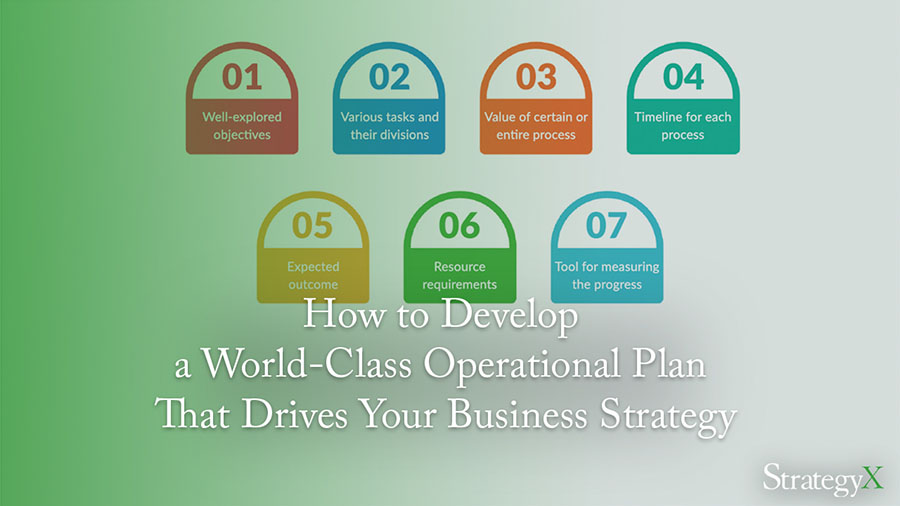You need to have a long-term vision to achieve your business objectives and gain a competitive advantage. Strategic planning helps you map out your goals for the next few years. But you'll also need bite-sized strategies for long-term plan execution.
That's why you have to develop an operational plan to outline the steps needed to fulfill these objectives. It assists you in laying out all daily, weekly, monthly, and yearly operations.
This post will cover all the steps needed to develop a world-class operation plan to drive business strategy.
What is an Operational Plan?
Consider an operational plan as a document consisting of all essential business operations for running a company successfully. It helps you detail the key objectives of the company and the steps to reach them.
An operational plan consists of the weekly and daily short-term objectives that can set you up to achieve long-term goals.
- You can include the responsibilities of various departments and the team members here
- It will assist in workflow planning and guide the team members to perform their daily operations
- It helps managers and employees understand their respective targets and associated deadlines
Along with establishing benchmarks for company targets, an operational plan will help your teams stay on track.
Steps to Create an Operational Plan
Your operational plan first describes departmental responsibilities, required resources, risks, and how everything is aligned to the company's missions. Let's break down the various steps in developing an operational plan.
Establish Long-Term Strategies
You have to define your long-term goals before establishing daily operations. These strategic objectives can be revenue enhancement, improving marketing campaigns, or better customer acquisition.
- Develop your strategies according to your company's market position.
- They need to support your organizational resources, budget, and workforce.
- These strategies must be clear and measurable.
You also have to establish a timeline according to these long-term strategies. These strategies will lay the foundation for your operational plan. And it will act as a strategy framework in the future.
Define Departmental Responsibilities and Scope
You have to establish the duties of each department in your company. So, establishing action plans for these departments is important for the employees to work towards the ultimate goal.
For instance, the marketing department will be responsible for social media management, content development, email marketing, and digital ads. It will help you understand the scope of your operational plan. However, it will depend upon your company's size.
Prioritize Essential Activities
Now that the departments know their duties, you need to define the most important activities of the plan. So, you have to notify all departments of the high-priority responsibilities or tasks they need to focus on.
This way, you can channelize the teams' energy towards a small or large task set instead of allocating multiple activities. It helps in business development and fulfilling your strategies. Also, it will enable you to optimize the available resources in the best possible way.
Set Key Performance Indicators
You need to define the key performance indicators for tracking your organization's progress. An excellent approach is to establish leading indicators for understanding the company's future.
These indicators can reach global markets or enhance customer satisfaction.
- Establishing and utilizing these indicators will help evaluate operational expenses, business requirements, and shortcomings.
- By tracking your organization's performance, you can analyze the risks associated with this operation plan or any long-term objective.
It can also assist you in including additional responsibilities for departments or officials.
Determine Stakeholders
Before crafting the final operational plan, you need to identify all the stakeholders involved. These are the officials who'll develop the plan for their respective departments.
For example, the creative head will establish the plan for the creative and marketing departments. Moreover, the financial head will develop the plan for the finance, accounts, and revenue department.
You can include the responsibilities of these key stakeholders for making the process smooth.
Communicate the Plan
The final step is to convey the operational plan to all the associated stakeholders. You might need to conduct meetings to share the updated plan. It is also a good time to fine-tune it to match the organizational objectives properly.
How Can Technology Help?
Strategy execution software such as StrategyX offers a strategic planning template that you can utilize to establish your initial objectives.
It will help you speed up the operational planning process. In addition, you can also monitor results using an integrated dashboard and work as a real-time strategic tool.
The Bottom Line
Developing a detailed operational plan clarifies your organizational objectives, missions, and desired outcomes. That enables you to manage your operations, processes, and teams better. As a result, it enhances the productivity and performance of your company.
With an operational plan in place, you can achieve your business strategies and analyze the possible risks. It will help you include business development software and experiment with strategies for boosting your business growth.



